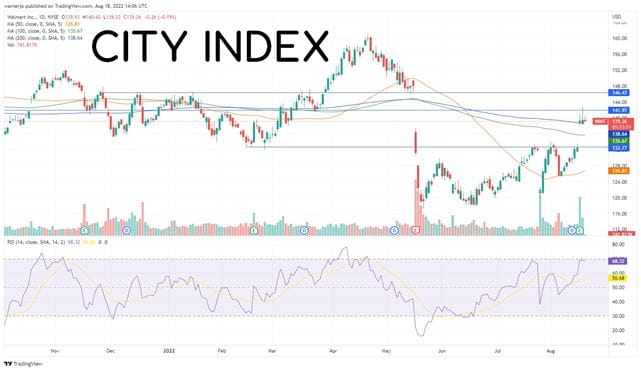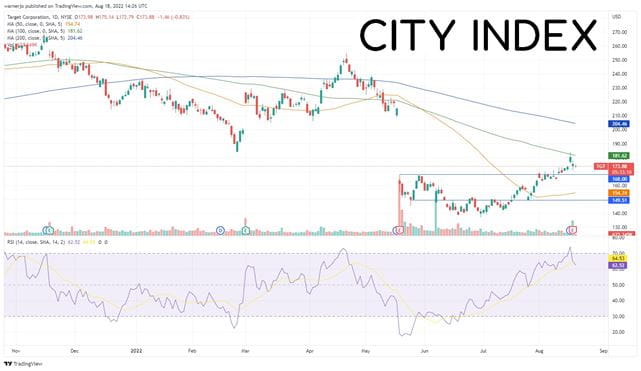
Retailers have had to adapt quicker than ever in recent years. The pandemic saw consumer habits evolve. The type of goods they wanted changed dramatically, and the way they bought them also shifted as people shopped online during lockdown. This year, retailers were busy preparing for consumer habits to normalise and return to what we saw before the pandemic hit.
However, rampant inflation, which hit a 40-year high in June, and the cost-of-living crisis that it has fuelled has thrown a new curveball that even the biggest retailers weren’t prepared for. With food prices sitting some 11% higher in July than a year ago and the cost of fuel up 40%, consumers are being forced to spend more on essentials and have less to spend on discretionary goods like clothing, homeware and electronics.
Walmart and Target struggle with inventory in Q2
This dramatic shift in consumer spending, while not unprecedented, caught both Walmart and Target off guard and the fact both have issued multiple profit warnings this year shows they have very little visibility over how the US consumer is coping. Both were saddled with billions of dollars worth of excess inventory that consumers could no longer afford, forcing them to slash prices in the second quarter in the hope of clearing their stock rooms. The widespread supply chain problems, combined with congested ports and Covid-19 disruption in the key manufacturing hubs of China, also meant they were not able to respond as swiftly as usual.
Still, both were successful in clearing stock in the second quarter as lower prices helped attract cost-conscious consumers. Walmart said comparable sales in the US rose 6.5%, which allowed the market-leader to significantly outpace the 2.6% growth delivered by Target.
Why did Walmart outperform Target?
One of the reasons Walmart delivered significantly faster growth is because it offers far more food, drink and groceries than its smaller rival. Walmart made over half of its sales from groceries in 2021, while Target only made 20%. Walmart has therefore benefited more as more spending shifts to food, and Target has had a much tougher time as it is far more exposed to general merchandise. An area that Target does boast an advantage over Walmart is in health and beauty, where sales have also held up well. Below is a table providing a rough outline on the mix of each company’s sales in 2021. Grocery relates to all food and drink, Health includes beauty and wellness products, and General Merchandise includes other forms of income.
|
Sales Mix, 2021 |
Grocery |
Health |
General Merchandise |
|
Walmart |
55% |
11% |
34% |
|
Target |
20% |
26% |
54% |
(Source: Company reports)
Walmart and Target forced to sacrifice profitability
Although both Walmart and Target have managed to keep growing sales thanks to the heavy discounts on offer, this has severely squeezed margins and eroded profitability. This has been further compounded by the fact that the sales mix has shifted to a greater proportion of food and drink, which offers significantly lower margins than most general merchandise. The result saw Walmart’s operating margin tighten to around 4.5% in the second quarter from 5.4% the year before. Meanwhile, Target’s margin suffered a much bigger collapse to just 1.2% from 9.8% a year ago. Target also underperformed on this front because of the greater exposure to general merchandise.
Target’s chief financial officer Michael Fiddelke said the 1.2% margin was ‘well below anything I've seen in my career and something I never expect to see again’. Target and Walmart both defended their decision to try to swiftly shift inventory and sacrifice profitability over the short term.
Is the outlook for US retailers improving?
News that sales growth was propped up by discounts and hurt profitability would usually be a recipe for disaster, but the share prices of both Walmart and Target have managed to gain ground since releasing their updates this week. That is because markets are hopeful that the second quarter will be the most troublesome period of 2022 and that things will improve in the second half.
Both Walmart and Target still have some excess inventory to shift in the third quarter, but most was sold in the second. Walmart said it initially focused most on getting rid of seasonal summer goods and is now concentrating on electronics, homeware and sporting goods. Target said its aggressive markdowns means it is in a ‘much better position as we head into the fall season’.
That should result in a recovery in margins in the second half, and both companies have seen an increase in footfall and traffic during the early stages on the third quarter. That sets a positive tone as we enter the key back-to-school season that will be followed by other major events that usually provide catalysts for sales including Halloween, Thanksgiving and the key shopping season over the Christmas holidays.
Profitability in the third quarter will improve from the second but will be below what was delivered the year before as the discounts continue. However, both companies believe things will be more normal in the fourth, and that will set the stage for what could be a much more rewarding year in 2023.
Will things improve for the US consumer?
Inflation remains hot, but the latest figures showed it slowed to 8.5% in June from the peak of 9.1% in June, installing hopes that we have finally reached peak inflation. That was predominantly driven by a drop in fuel prices, which freed up more money for consumers to spend elsewhere. The result saw retail sales hold steady in July compared to the previous month, which has also allayed fears of a slowdown in spending. In fact, sales were up 0.7% when fuel and cars were excluded.
Wages are also climbing higher, even if they are failing to keep up with inflation, and consumers are thought to have a healthy sum of savings. The 2022 Planning & Progress study released by Northwestern Mutual said around 60% of Americans have increased their savings over the last two years and almost 70% plan to keep them high going forward. Still, the cost-of-living crisis appears to already be eating away at people’s rainy-day funds, with average personal savings falling to $62,000 in 2022 from $73,000 in 2021. Consumers also remain confident that they can remain financially stable and the majority believe they won’t go short going forward.
Will Walmart and Target change their outlook again?
Taken together, the economic outlook looks rosier than it did a month ago and has ignited hopes that the worst is behind us, consumer spending will remain resilient and that a recession can be avoided. Still, the economic outlook remains volatile and there is no sign of any relief on the horizon for many that are feeling the pinch, making things highly uncertain. For example, the Federal Reserve is not convinced the latest CPI data is enough to change its direction and is waiting for more evidence that inflation is cooling.
Similarly, retailers are also taking a cautious view and it is likely that we could see Walmart and Target refine their guidance again before the year is out. Walmart admitted this week that it has been difficult to predict the wild swings in consumer’s shopping habits, explaining why it has tweaked its guidance on several occasions this year. Its expectations for the second half assume ‘no changes’ from the second quarter, but we already know that the situation will be very different. That suggests there is scope for guidance to evolve further.
Target has said there are ‘early signs’ that it is past the peak of its problems. Costs are starting to drop from their recent peaks and supplies are starting to move quicker. But it too remains wary and concedes that conditions remain ‘highly unfavourable’ compared to before the pandemic and several threats linger on the horizon.
For now, Walmart has said it expects to deliver US comparable sales growth of around 3% in the second half of the year to provide a full-year figure of 4%. Annual adjusted operating profit will be down 9% to 11% from 2021, having previously warned it could slide as much as 13%. Target said sales will be up by a low-to-single digit this year and is aiming to grow its operating margin back to 6% in the second half. Wall Street currently believes Target will deliver slower US comparable sales growth and a much bigger drop in operating profit this year compared to Walmart given their different sales mix.
Where next for WMT stock?
Walmart shares have so far managed to keep up the momentum after its improved outlook sent shares to three-month highs this week, but it could become harder to find higher ground from here.
The first upside target going forward is $142, which has emerged as a level of both support and resistance since the start of the pandemic, but it is ultimately looking to recapture $146.50, which would close the gap created when it released first quarter earnings back in May. The 41 brokers that cover Walmart see slightly greater upside potential with an average target price of $149.75. Trading volumes have risen during the past five trading sessions and remain strong today, helping provide support to the rally.
However, the RSI is on the cusp of entering overbought territory and the gains have been harder to come by yesterday and today, with the stock trading lower this morning. Investors will hope the 200-day moving average at $138.60 can hold as a new floor now that it has been recaptured, or the 100-day moving average at $135.70, but a return to sub-$133 remains a possibility if it comes under renewed pressure following the recent spike.

Where next for TGT stock?
Target’s underperformance in the latest quarter means the stock has not leapt higher alongside its larger rival. The stock has been on the rise since rebounding from two-year lows in late June, but is also under struggling to find higher ground today.
Immediate upside potential is capped by $209, where it sat before it too plunged lower upon released disappointing results back in May. However, this could be tougher for Target shares. The RSI slipped into oversold territory upon testing the 100-day moving average and the share price has lost steam since then despite an explosion in volumes, suggesting $181.60 is the initial ceiling to break. The 33 brokers that cover Target see limited upside potential from current levels with an average target price of $191.30.
If the stock loses momentum, then we could see it slip back toward $168, where it sat after gapping lower in May and in-line with its pandemic-induced lows back in March 2021. Beyond there, $150 comes back into play.

How to trade Walmart and Target
You can trade Walmart and Target shares with City Index in just four easy steps:
- Open a City Index account, or log-in if you’re already a customer.
- Search for ‘Walmart’ or ‘Target’ in our award-winning platform
- Choose your position and size, and your stop and limit levels
- Place the trade
Or you can try out your trading strategy risk-free by signing up for our Demo Trading Account.





